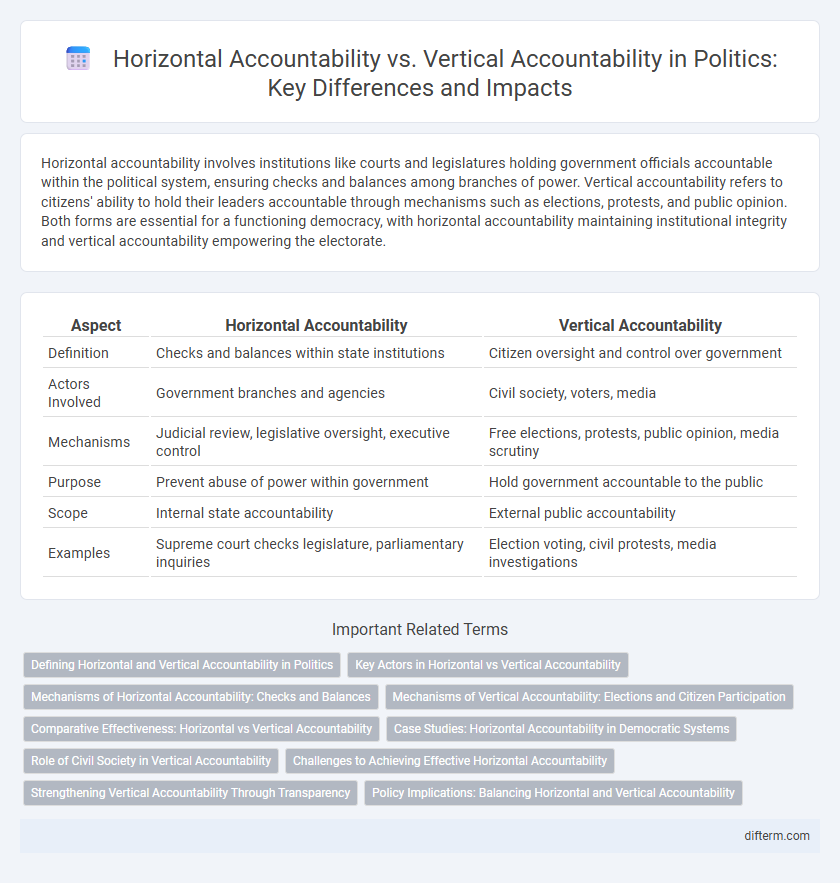Horizontal accountability involves institutions like courts and legislatures holding government officials accountable within the political system, ensuring checks and balances among branches of power. Vertical accountability refers to citizens' ability to hold their leaders accountable through mechanisms such as elections, protests, and public opinion. Both forms are essential for a functioning democracy, with horizontal accountability maintaining institutional integrity and vertical accountability empowering the electorate.
Table of Comparison
| Aspect | Horizontal Accountability | Vertical Accountability |
|---|---|---|
| Definition | Checks and balances within state institutions | Citizen oversight and control over government |
| Actors Involved | Government branches and agencies | Civil society, voters, media |
| Mechanisms | Judicial review, legislative oversight, executive control | Free elections, protests, public opinion, media scrutiny |
| Purpose | Prevent abuse of power within government | Hold government accountable to the public |
| Scope | Internal state accountability | External public accountability |
| Examples | Supreme court checks legislature, parliamentary inquiries | Election voting, civil protests, media investigations |
Defining Horizontal and Vertical Accountability in Politics
Horizontal accountability in politics refers to the mechanisms through which state institutions, such as the judiciary, legislature, and executive branches, monitor and check each other's power to prevent abuses and ensure compliance with laws. Vertical accountability involves the ability of citizens, civil society, and the media to hold political leaders and public officials accountable through elections, protests, and public opinion. Effective governance requires a balance between horizontal accountability, which institutionalizes checks and balances within government structures, and vertical accountability, which empowers citizens to influence political decision-making.
Key Actors in Horizontal vs Vertical Accountability
Horizontal accountability is ensured primarily by state institutions such as the judiciary, legislature, and independent oversight bodies that monitor and restrain executive power. Vertical accountability involves citizens, civil society organizations, the media, and electoral processes that hold government officials responsible through voting, protests, and public scrutiny. Key actors in horizontal accountability emphasize institutional checks and balances, while vertical accountability relies on participatory mechanisms to promote political transparency and responsiveness.
Mechanisms of Horizontal Accountability: Checks and Balances
Mechanisms of horizontal accountability encompass institutional checks and balances designed to regulate power among branches of government, such as the judiciary's ability to review legislation and executive actions. These mechanisms include legislative oversight, judicial review, and autonomous anti-corruption bodies that prevent abuses and ensure compliance with the rule of law. The effectiveness of horizontal accountability hinges on the independence and strength of these institutions to hold each other accountable within a political system.
Mechanisms of Vertical Accountability: Elections and Citizen Participation
Elections serve as the primary mechanism of vertical accountability by enabling citizens to hold government officials responsible for their performance through voting and political competition. Citizen participation extends beyond voting to include activities such as protests, petitions, and engagement with civil society organizations, empowering the electorate to influence policymaking and government behavior directly. These mechanisms collectively strengthen democratic governance by ensuring that power remains responsive and accountable to the people.
Comparative Effectiveness: Horizontal vs Vertical Accountability
Horizontal accountability involves checks and balances within state institutions like the judiciary and legislature to prevent abuse of power, providing more direct and technical oversight of government actions. Vertical accountability relies on citizens, media, and civil society to hold political leaders accountable through elections and public opinion, fostering democratic participation but often subject to electoral politics and public awareness. Comparative effectiveness indicates horizontal mechanisms ensure institutional constraints and rule enforcement, while vertical accountability drives responsiveness and legitimacy, making a balanced integration essential for robust governance.
Case Studies: Horizontal Accountability in Democratic Systems
Horizontal accountability in democratic systems involves institutions such as independent judiciaries, legislative oversight committees, and autonomous anti-corruption agencies that monitor and check executive power within the government framework. Case studies reveal that countries like Sweden and South Korea demonstrate effective horizontal accountability through robust institutional checks that prevent abuses of power and ensure transparent governance. These mechanisms complement vertical accountability by reinforcing rule of law and fostering political stability through internal governmental scrutiny.
Role of Civil Society in Vertical Accountability
Civil society plays a crucial role in vertical accountability by enabling citizens to hold government officials and institutions accountable through mechanisms such as protests, advocacy, and public campaigns. It facilitates transparency and responsiveness by mobilizing public opinion and fostering informed citizen participation in democratic processes. Effective vertical accountability depends significantly on the strength and independence of civil society organizations to monitor government behavior and demand accountability.
Challenges to Achieving Effective Horizontal Accountability
Challenges to achieving effective horizontal accountability include institutional weakness, political interference, and lack of independence among oversight bodies such as courts, audit agencies, and anti-corruption commissions. Fragmented power structures often result in unclear responsibilities and limited enforcement capacity, undermining transparency and accountability mechanisms. Furthermore, political actors may manipulate horizontal accountability institutions to serve partisan interests, weakening checks and balances in governance.
Strengthening Vertical Accountability Through Transparency
Strengthening vertical accountability through transparency enhances citizens' ability to monitor government actions and hold public officials responsible for policy outcomes and ethical conduct. Transparent information dissemination enables media, civil society, and voters to scrutinize government performance, thereby increasing responsiveness and reducing corruption. Effective vertical accountability requires accessible, reliable data and mechanisms that encourage public participation and feedback in political processes.
Policy Implications: Balancing Horizontal and Vertical Accountability
Balancing horizontal accountability, which involves oversight by institutions such as courts and legislatures, with vertical accountability from citizens through elections is crucial for effective governance and policy implementation. Policies fostering transparency, institutional checks, and citizen participation can strengthen both forms of accountability, reducing corruption and enhancing public trust. Prioritizing this balance ensures that government actions are responsive, accountable, and aligned with democratic principles.
horizontal accountability vs vertical accountability Infographic

 difterm.com
difterm.com